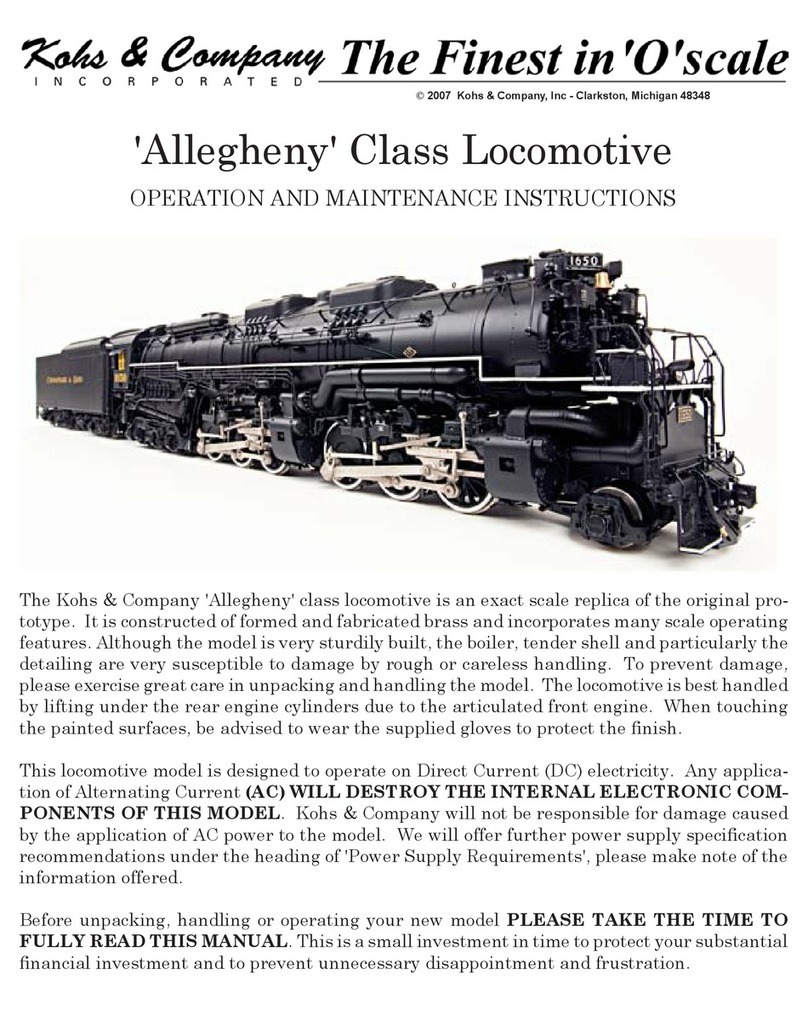
PREPARING THE SOUND SYSTEM FOR OPERATION
The locomotive and tender contain a state-of-the-art sound system which digitally recreates actual locomo-
tive sounds including steam whistle, bell, blowers, compressors, emergency relief valve and cylinder ex-
haust chuff. While this sound unit requires track voltage to actuate certain sounds, the actual power used
to operate the sound system is supplied by two standard 9 volt batteries that are placed in the tender coal
bunker during operation of the locomotive, the batteries and wiring harness are packed in the box along
with the locomotive and tender. At the end of the wiring harness is a male plug which needs to be inserted
into the receptacle under the bearing box hatch cover on the floor of the bunker, with this connection made,
the coal load can be placed over the batteries to
conceal their installation. When you unplug the
batteries, do not pull on the wires, only the
plug shell.
NOTE: Your tender and sound control unit
come equipped with batteries. If you do
not plan to use your locomotive for an ex-
tended period of time it is highly recom-
mended that you remove these batteries.
The supplied sound system controller needs to
be wired in-line between your power supply and
the track in order to control the internal sound
system. There are four (4) screw terminals inside the control box which are labeled 'track' and 'cab'. To
allow easy access to these terminals, we left the upper and lower control-box shells unassembled. The
assembly screws and rubber feet are included inside the box for use after your connections have been made.
The tender was shipped to you with a scale 'tite-lock' style coupler installed for display purposes. For
operating and pulling consists you may replace the display coupler with the Kadee unit of your choice, the
holes are predrilled and tapped for the installation.
OPERATING THE LOCOMOTIVE
It is recommended that you operate the locomotive at a varying speeds and in both directions during the
break-in period, the break-in period should last for a total of approximately 60 minutes (this may be accom-
plished on an incremental basis). This will help the drive system to 'run-in' resulting in smoother running
characteristics.
You are now ready to put the locomotive into operation. To activate the sound system, locate the sound
system switch under the water tank hatch (see figure #3). Shortly after turning the system on you will
hear the blowers activate. With the locomotive stationary you will hear, in addition to the blowers, the air
compressors and pressure relief valves on an intermittent basis. When 'track' power is applied to the loco-
motive, the blowers will turn off and the brake release will sound. As soon as the drivers begin to turn, the
chuffing of the cylinder exhausts will start in independent synchronization with each set of drivers. When
the loco is brought to a stop, the blowers will again start up while the intermittent sounds continue. The
whistle may be sounded at any time, when the system is turned on. The bell may be activated by touching
the control button once to turn it on and again to turn it off.
(figure #2)
Should you choose to use a less expensive power supply or one which does not meet the above criteria,
undesirable operating characteristics may result as well as possible damage to the electronics used in the
model. If you have questions regarding your selection, do not hesitate to contact us for advise.

























